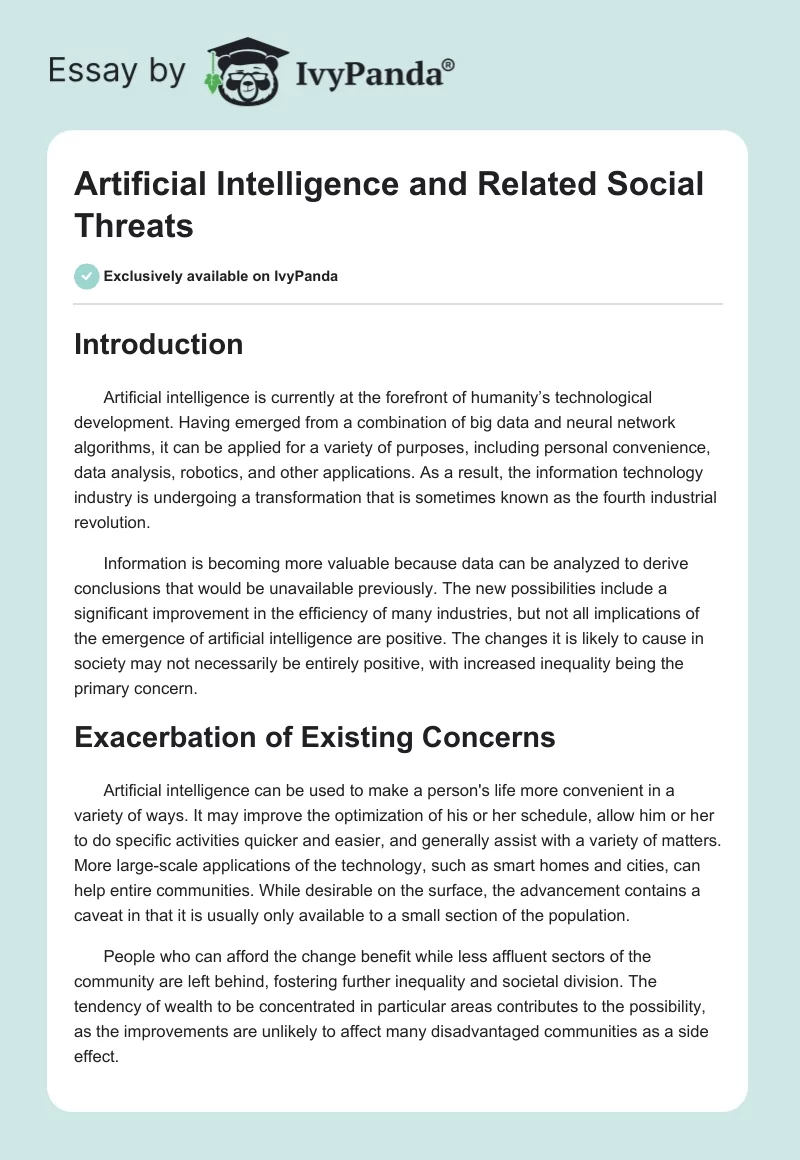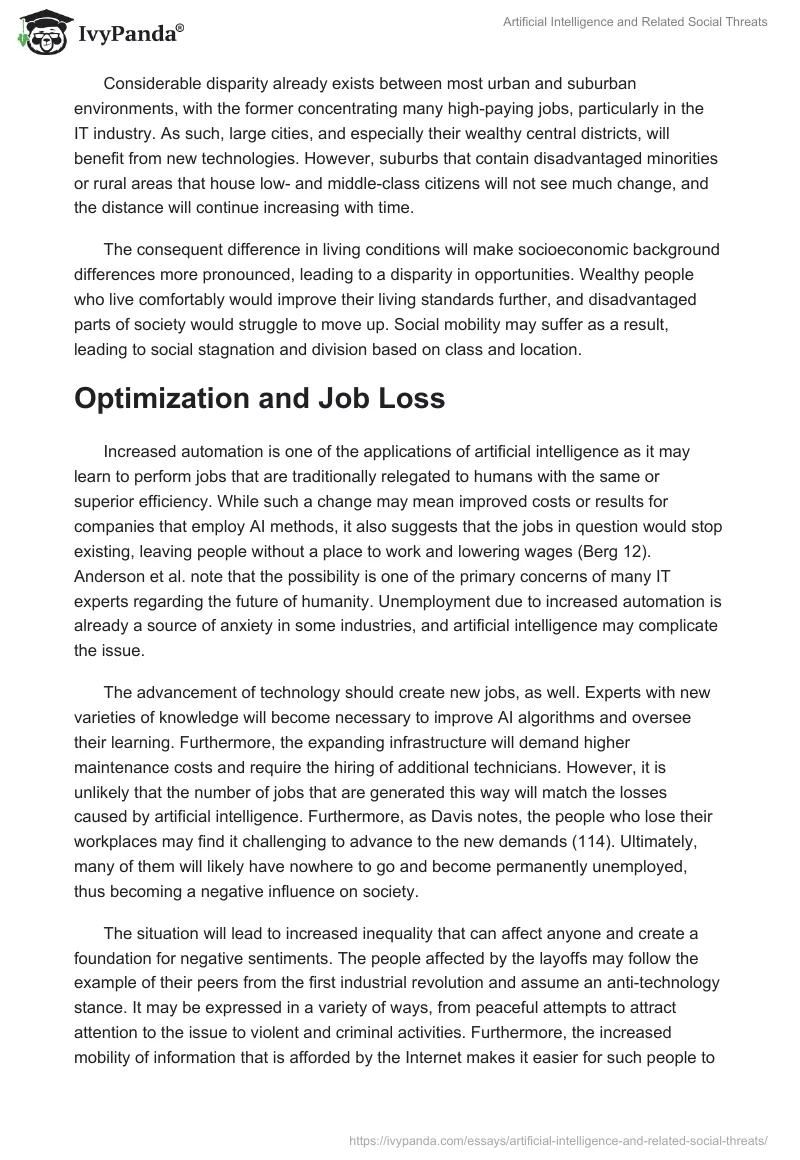Introduction
Artificial intelligence is currently at the forefront of humanity’s technological development. Having emerged from a combination of big data and neural network algorithms, it can be applied for a variety of purposes, including personal convenience, data analysis, robotics, and other applications. As a result, the information technology industry is undergoing a transformation that is sometimes known as the fourth industrial revolution.
Information is becoming more valuable because data can be analyzed to derive conclusions that would be unavailable previously. The new possibilities include a significant improvement in the efficiency of many industries, but not all implications of the emergence of artificial intelligence are positive. The changes it is likely to cause in society may not necessarily be entirely positive, with increased inequality being the primary concern.
Exacerbation of Existing Concerns
Artificial intelligence can be used to make a person’s life more convenient in a variety of ways. It may improve the optimization of his or her schedule, allow him or her to do specific activities quicker and easier, and generally assist with a variety of matters. More large-scale applications of the technology, such as smart homes and cities, can help entire communities. While desirable on the surface, the advancement contains a caveat in that it is usually only available to a small section of the population.
People who can afford the change benefit while less affluent sectors of the community are left behind, fostering further inequality and societal division. The tendency of wealth to be concentrated in particular areas contributes to the possibility, as the improvements are unlikely to affect many disadvantaged communities as a side effect.
Considerable disparity already exists between most urban and suburban environments, with the former concentrating many high-paying jobs, particularly in the IT industry. As such, large cities, and especially their wealthy central districts, will benefit from new technologies. However, suburbs that contain disadvantaged minorities or rural areas that house low- and middle-class citizens will not see much change, and the distance will continue increasing with time.
The consequent difference in living conditions will make socioeconomic background differences more pronounced, leading to a disparity in opportunities. Wealthy people who live comfortably would improve their living standards further, and disadvantaged parts of society would struggle to move up. Social mobility may suffer as a result, leading to social stagnation and division based on class and location.
Optimization and Job Loss
Increased automation is one of the applications of artificial intelligence as it may learn to perform jobs that are traditionally relegated to humans with the same or superior efficiency. While such a change may mean improved costs or results for companies that employ AI methods, it also suggests that the jobs in question would stop existing, leaving people without a place to work and lowering wages (Berg 12). Anderson et al. note that the possibility is one of the primary concerns of many IT experts regarding the future of humanity. Unemployment due to increased automation is already a source of anxiety in some industries, and artificial intelligence may complicate the issue.
The advancement of technology should create new jobs, as well. Experts with new varieties of knowledge will become necessary to improve AI algorithms and oversee their learning. Furthermore, the expanding infrastructure will demand higher maintenance costs and require the hiring of additional technicians. However, it is unlikely that the number of jobs that are generated this way will match the losses caused by artificial intelligence. Furthermore, as Davis notes, the people who lose their workplaces may find it challenging to advance to the new demands (114). Ultimately, many of them will likely have nowhere to go and become permanently unemployed, thus becoming a negative influence on society.
The situation will lead to increased inequality that can affect anyone and create a foundation for negative sentiments. The people affected by the layoffs may follow the example of their peers from the first industrial revolution and assume an anti-technology stance. It may be expressed in a variety of ways, from peaceful attempts to attract attention to the issue to violent and criminal activities. Furthermore, the increased mobility of information that is afforded by the Internet makes it easier for such people to coordinate and spread their message throughout society. It is essential to attempt to address the issue before it becomes prominent and causes marginalization or radicalization of previously peaceful people.
It should be noted that the prevailing view on the issue represents a somewhat extreme scenario. Boyd and Holton indicate that a range of possibilities exists between the dystopian and utopian options, and it is likely that the situation will follow one of them (343).
Job loss is likely inevitable, but as long as industries and technologies keep evolving, new possibilities should arise, particularly for educated workers whose posts are now threatened by artificial intelligence. The optimal solution will likely be reached through democratic discourse, which involves acceptance of the opposing viewpoint and the search for a compromise. To that end, people should adopt rational perspectives when discussing the issue.
Big Data and Information Asymmetry
The knowledge that can be extracted from data samples includes personal information, leading to concerns over privacy in the age of artificial intelligence. Marr warns about such possibilities, providing China’s social credit system as an example of an approach that governs the lives of people and restricts their opportunities using an algorithm. The biggest issue here is the inequality in the availability of information between individuals and governments, or corporations. Large organizations are likely to have access to data aggregates and analysis tools that people cannot afford, giving them significant and unwarranted power over many persons. The information may be used for a variety of purposes, most of which do not benefit the targets.
Marketing is one of the most prominent disciplines where artificial intelligence is causing considerable changes. Advanced algorithms can determine someone’s preferences and suggest items or services that the person is likely to buy.
As noted by Marr, this technique may become manipulative when taken to its logical conclusion. It can lead people to spend money on goods they do not need for the benefit of a corporation or subtly influence his or her beliefs and opinions over time to align with some agenda. If such a method were employed, it would be difficult to discern or prove that it is taking place because algorithmic complexity and obfuscation provide deniability. The possibility would threaten many ideas that are considered fundamental to modern humanity, calling the concept of free will into question.
The knowledge could be used to other ends besides outright manipulation, skewing the dynamics of power further from the individual. Lepri et al. note that in addition to its exclusive knowledge, an algorithmically-assisted government would operate in a less transparent and accountable fashion (10). The possibility contributes to a move away from a democratic system, with power becoming concentrated around a small number of large impersonal entities that would defy scrutiny. There are many possible social implications of such a change, but few of them are positive, as such groups would not have an incentive to consider the social good. It is likely that the divide would contribute to the creation of a regressive system with different privileges for people based on their social group.
Data Analysis and Discrimination
The ability of artificial intelligence to analyze trends is a considerable strength of the technology. It allows companies to analyze trends and make predictions about particular societal groups, their preferences, views, and intentions. However, such analyses can lead to adverse consequences when employed in background checks or crime prevention programs. Lepri et al. provide the example of the algorithmic association of African American people with criminal neighborhoods and the consequent suspicion from the police or job application refusal (11).
Such policies would constitute discrimination and contradict most, if not all, country legislation as well as human rights. Such outcomes are easy to identify when they concern racial, ethnic, and other groups that have experienced discrimination in the past, and so researchers are currently often able to identify cases of discrimination.
However, the low accountability of artificial intelligence algorithms means that it may identify population categories that do not share a common trait that would be apparent to a person and discriminate against them. The enormous variety of information available on the Internet allows the collection of numerous data points that can show commonalities between unconnected people. A system where artificial intelligence is used to determine whether a person will receive particular benefits may show bias against someone for no apparent reason. It would lead to increased inequality, mainly if the algorithm were used by law enforcement or for other purposes that significantly affect people’s lives.
It should be noted that artificial intelligence-driven data collection is less useful for determining specific facts about people than for general trend evaluation. According to Lawless et al., while it is possible to apply analytical methods to human behaviors, they would have limited utility (81). While this conclusion means that it is going to be challenging to gather data on specific individuals, it also creates concerns over blind trust in the power of the algorithms. As was mentioned above, their processes are often not accountable. Therefore, if a system yields an incorrect conclusion and it is believed, innocent people could suffer as a result.
Conclusion
The introduction of artificial intelligence into various parts of human life is associated with numerous social risks and dangers. Assuming the new technology benefits individuals, it may deepen the divide between those who can afford it and those who cannot.
The new capabilities may also automate particular tasks, making some jobs obsolete and creating unemployment. It should also be noted that most artificial intelligence capabilities are concentrated in the hands of large corporations and governments, giving them considerable power over individuals. Lastly, when the complicated and unaccountable nature of many complex algorithms is taken into account, it becomes possible that they may discriminate against specific categories of people without anyone realizing it. These issues should be addressed before artificial intelligence can be fully employed in its broad range of applications.
Works Cited
Anderson, Janna, et al. “Artificial Intelligence and the Future of Humans.” Pew Research Center. 2018. Web.
Berg, Andrew, et al. “Robots, Growth, and Inequality.” Finance & Development, vol. 53, no. 3, 2016: pp. 10-13.
Boyd, Ross, and Robert J. Holton. “Technology, Innovation, Employment and Power: Does Robotics and Artificial Intelligence Really Mean Social Transformation?” Journal of Sociology, vol. 54, no. 3, 2018: pp. 331-345.
Davis, Nicholas. “The Future Relationship between Technology and Inequality.” How Unequal? Insights on Inequality, Committee for Economic Development of Australia, 2018, pp. 110-130.
Lawless, W.F., et al., editors. Autonomy and Artificial Intelligence: A Threat or Savior? Springer, 2017.
Lepri, Bruno, et al. “The tyranny of Data? The Bright and Dark Sides of Data-Driven Decision-Making for Social Good.” Transparent Data Mining for Big and Small Data, edited by Tania Cerquitelliet al., Springer, 2017, pp. 3-24.
Marr, Bernard. “Is Artificial Intelligence Dangerous? 6 AI Risks Everyone Should Know About.” Forbes. 2018. Web.


